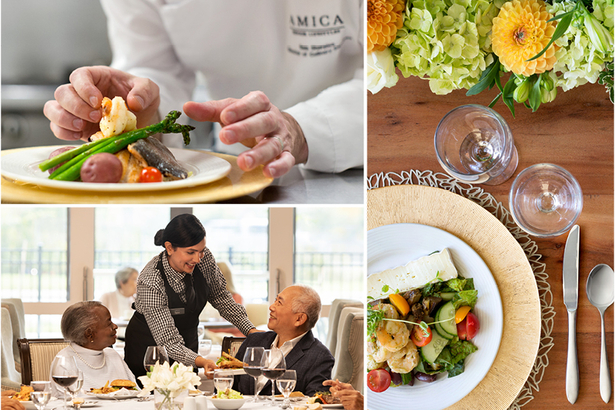
But exceptional meals like these are just a few of the delicious dishes offered at Amica Senior Lifestyles, which has established a reputation for its outstanding, Red Seal-standard cuisine.
Food and nutrition are crucial in seniors’ lives, and transitioning from preparing their own meals to having meals prepared for them can be a big adjustment. Amica enhances the dining experience through its culinary program, focusing on taste, presentation, and essential vitamins and minerals for a healthy life. “We use only the best ingredients,” says Robert Linder, chef, Director of Culinary Services, and 30-year veteran at Amica Senior Lifestyles. “With the best ingredients, you get the best outcome.”
Here are five reasons why Amica’s culinary program is a cut above the rest.
#1: Diverse flavours
At Amica, you’re not likely to find the same dish on the menu twice, as menus are updated frequently featuring different seasonal ingredients. “We have 126 different entrees per month,” says Gary McBlain, National Director of Culinary at Amica Senior Lifestyles, who designs the menus for Amica’s residences. “We have different desserts daily for both lunch and dinner, different soups, and different salads for lunch and dinner every week. We’re always changing up the menu to add variety.”
Residents can choose from chef-prepared daily specials or options from an à la carte menu. “We use the philosophy of batch cooking, where we cook the food to order, and it's plated individually for each resident,” says McBlain. Beyond that, McBlain says Amica’s chefs will even go the extra mile and make something customized for residents. “We are more than happy to make something with ingredients they love and enjoyed when living on their own.”
#2: Accommodating for stage of life and special needs
When creating menus, McBlain also considers the physical changes caused by aging. For seniors with difficulty chewing due to weakened jaws or dental issues, Amica chefs braise ribs, beef stew, or a leg of lamb to keep them moist. For example, “We serve pork tenderloin instead of pork loin so the meat stays tender and doesn’t dry out,” says McBlain.
To alleviate dry mouth caused by certain medications, chefs enhance flavour, moisture, and texture with a variety of sauces — essential tools in the repertoire of world-class chefs. For example, “fish might arrive with lemon sauce or tomato salsa on the side.”
Meanwhile, Amica’s chefs always prioritize accommodating residents’ special diets. “We can accommodate any special diet that people might have, whether it's gluten-free, low fat, a diabetic diet, or modified diets for people who might have trouble swallowing.”
#3: Healthy choices
Meals at Amica are not only delicious but also dietitian-approved and packed with key vitamins and minerals seniors need. Menus follow Canada’s Food Guide, which means lots of vegetables and whole grains. “Our chefs use only fresh ingredients,” says McBlain. From basil to cilantro and chopped garlic, “I love using fresh herbs and spices in food because they add that extra element and taste healthy.”
Preparing tasty meals is especially important for seniors, as their sense of smell — directly related to taste — diminishes over time. Amica chefs use herbs, spices, or brown meats to add flavour without compromising health. One of McBlain’s favourite sides: mango-chipotle sweet potatoes tossed with olive oil and a spice rub. “You get a ton of flavour without adding sugar or salt.”
#4: Supreme dining experience
“Presentation is everything,” says Linder. “The residents appreciate something presented beautifully; they remember it the next day.” To that end, dishes — from entrées to desserts — are plated artfully with thoughtful garnishes that whet appetites and elevate the dining experience.
The atmosphere in which you enjoy your meal can be just as important as the dish itself, and at Amica, dining options are plentiful. Enjoy your meals while catching up with friends in beautifully appointed, fully licensed dining rooms, or dine on the courtyard patio. You can also order takeout or room service. “Residents can come to the dining room any time they want — they don't have to come down at a set time or sit at a specific table. It's completely open dining,” says McBlain. Between meals, residents can help themselves to delicious, healthy snacks and beverages any time from the residence’s self-serve bistro.
For special occasions, Amica’s chefs can collaborate with residents on custom menus for family gatherings in the private dining room. “This is when our chefs truly showcase their skills and present absolutely stunning dishes.”
#5: Resident-led
Listening to residents’ needs also means that the dining experience at Amica is always evolving, courtesy of resident feedback. Amica Riverside has an official food council that includes the Director of Culinary and five to six residents. They gather monthly to share residents’ preferences and spot opportunities, discussing everything from the menu and seating to service and ambiance. This creates a constant feedback loop that leads to the creation of excellent dishes, cultural cuisines and a diligent effort to please taste buds at every meal. Other residences have a similar feedback process. The result: Good food, prepared well.
McBlain, who spent years in the restaurant industry before he transitioned to retirement living, has a simple goal: providing wonderful food and great service for Amica residents. “ The best part of this position is having the flexibility to create special meals for residents who have been the bedrock of their communities and have chosen to live with us. Food truly brings people together, so it’s an honour to nourish seniors and their relationships every day.”
About Gary McBlain, National Director of Culinary
Gary is a Red Seal-certified chef who has a passion for creating healthy meals using fresh
ingredients. His passion for cooking began in his early teens, when he started cooking dinner for his family. Chef McBlain trained at Niagara College’s Culinary Institute and apprenticed at local restaurants
that focused on fresh local cuisine. After several years in the restaurant industry, he made the
transition to retirement living and has been working with Amica for more than 10 years.
